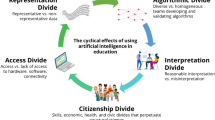Abstract
Curriculum reform efforts usually have ignored the culture in which curriculum is embedded. Principal components of the culture are the knowledge of teachers and the myths of this culture. Images, metaphors, and metonymies are forms of teacher knowledge that influence the manner in which teachers define their roles and implement the curriculum. Unless endeavors are made to facilitate teacher learning through the construction of new images, metaphors, and metonymies, it is unlikely that curricular reform will proceed in the intended manner. Similarly, the myths that define the customs and taboos of a culture need to be considered by instructional designers if their curricular resources are to be used as intended. The myths ofteacher as controller of students andobjectivism together might persuade teachers to adhere to the more traditional approach whereby knowledge is transferred to students in teacher-controlled activities.
This article describes theScience Vision series, a hypermedia system developed in response to a clear need for additional resources to educate teachers concerning alternative myths and their use in relation to utilizing resources.
Similar content being viewed by others
References
Bowen, C., & Dawson, G. (1991).Student and teacher outcomes: Results from national field testing with the IMS materials. Unpublished Manuscript, Florida State University, Tallahassee.
Carin, A. A., & Sund, R. B. (1989).Teaching science through discovery (6th ed., pp. 92–103). Columbus: Merrill.
Clandinin, D. J. (1986).Classroom practice: Teachers' images in action. London: Falmer Press.
Dawson, G. O. (Principal Investigator). (1991).ScienceVision. Boston: Houghton Mifflin.
Elbaz, F. L. (1983).Teacher thinking: A study of practical knowledge. London: Croom Helm.
Gitlin, A. D. (1987). Common school structures and teacher behavior. In J.W. Smyth (Ed.),Educating teachers: Changing the nature of pedagogical knowledge (pp. 107–120). London: Falmer Press.
Grundy, S. (1987).The curriculum: Product or praxis? London: Falmer Press.
Hawkins, D. (1965). Messing about in science. InThe ESS Reader (pp. 37–44). Newton, MA: Elementary Science Study.
Hinnells, J. R. (1985).Persian mythology. New York: Peter Bedrick Books.
Johnson, M. (1987).The body in the mind: The bodily basis of meaning, imagination, and reason. Chicago: University of Chicago Press.
Lakoff, G. (1987).Women, fire, and dangerous things: What categories reveal about the mind. Chicago: University of Chicago Press.
Marshall, H. H. (1990). Beyond the workplace metaphor: The classroom as a learning setting.Theory into Practice, 29(2), 94–101.
Munby, H., & Russell, T. (1990). Metaphor as an instructional tool in encouraging student teacher reflection.Theory into Practice, 29(2), 116–121.
Paivio, A. (1974). Images, propositions, and knowledge. In M. Nicholas (Ed.),Images, perception, and knowledge. Dordrecht, The Netherlands: D. Reidel Publishing Co.
Putnam, H. (1981).Reason, truth, and history. Cambridge: Cambridge University Press.
Sanders, D. P., & McCutcheon, G. (1986). The development of practical theories of teaching.Journal of Curriculum and Supervision, 2(1), 50–67.
Schwab, J. J. (1963).The teaching of science as inquiry. Cambridge: Harvard University Press.
Tobin, K. (1990a). Social constructivist perspectives on the reform of science education.Australian Science Teachers Journal, 36(4), 29–35.
Tobin, K. (1990b). Teacher mind frames and science learning. In K. Tobin, J. B. Kahle, & B. J. Fraser (Eds.),Windows into science classrooms: Problems associated with high level cognitive learning in science (pp. 33–91). London: Falmer Press.
Tobin, K. (1990c). Changing metaphors and beliefs: A master switch for teaching.Theory into Practice, 29(2), 122–127.
Tobin, K., & Ulerick, S. J. (1989, March).An interpretation of high school science teaching based on metaphors and beliefs for specific roles. Paper presented at the annual meeting of the American Educational Research Association, San Francisco.
von Glasersfeld, E. (1989). Cognition, construction of knowledge, and teaching.Syntheses, 80(1), 121–140.
Author information
Authors and Affiliations
Rights and permissions
About this article
Cite this article
Tobin, K., Dawson, G. Constraints to curriculum reform: Teachers and the myths of schooling. ETR&D 40, 81–92 (1992). https://doi.org/10.1007/BF02296708
Issue Date:
DOI: https://doi.org/10.1007/BF02296708




